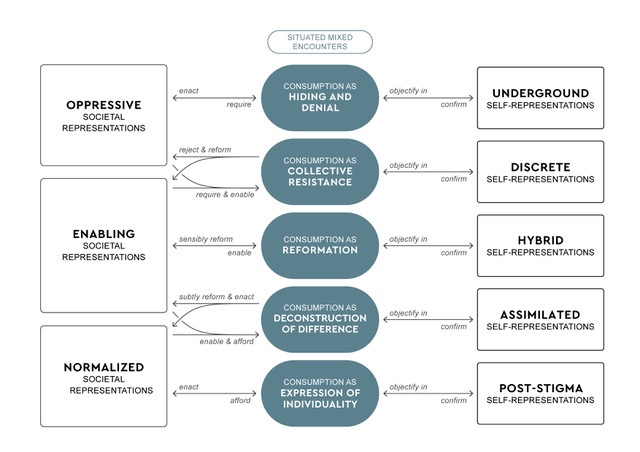Somewhere over the rainbow: New study explains why the ‘gay community’ has fallen apart
Research at Bayes shows that fading anti-gay stigma has fuelled the disintegration of the gay community and given rise to new gay lifestyles that compete for respect.
New research by Bayes Business School and Goldsmiths, University of London has found that declining anti-gay stigma in Western societies has resulted in the splintering of the gay community into five separate lifestyles.
Over a period of seven years, the authors explored how gay teachers, civil servants, students, or soldiers, among others, see themselves as members of a gay community and a broader society.
Research had long recognised that gay men were as diverse as any other social group. However, they had previously been forced into a "gay community" by a dominant anti-gay stigma. In demarkated gay neighborhoods, bars, organisations, and similar institutions they were able to support each other and collectively fight stigmas.
Grounded in data from Germany, this new research explores how these differences come to light once those external pressures subside. The researchers found that the stereotypical “gay subculture” or “gay community” of the 1990s has disintegrated into five distinct groups which they call underground, discrete, hybrid, assimilated, and post-gay groups.
Which of these five groups a gay man primarily identifies with depends on the degree of stigma they face in their everyday lives. Identification with one of the five groups is also reflected in gay men’s consumption behaviour:
1. Underground gay men are still not afforded the social space to exist as openly gay. For them being ‘outed’ would result in exclusion from their families and circles of friends, job loss, or even physical violence. Underground gay men therefore avoid market offerings that are considered stereotypically gay, such as skinny jeans, golden Adidas sneakers, or plucked eyebrows, and consume in deliberately “straight” ways.
2. Discrete gay men enjoy enough recognition and legal protection to be openly gay. They feel tolerated, but not respected in society, and wish to protect their distinct gay lifestyle and subcultural heritage. Discrete gay men therefore prefer gay neighbourhoods, expressive gay fashion styles, explosive pride parades, and stereotypical gay identities that have characterised members of the “gay subculture” or “gay community” men since the 1980s.
3. Hybrid gay men live in an innovative space in between gay and straight worlds. They use their high social status to inject gay consumption practices into heteronormative spheres, but also hetero practice into gay spheres. Gay football fan clubs or queered wedding ceremonies are prime examples.
4. Assimilated gay men are fully accepted by their families, friends, and workplaces, but only under the condition that stay away from gay politics, identities, and (discrete) gay subcultures. For the broader society, these men are respected as “completely normal” if they live and consume just like heterosexual men.
5. Post-gay men are the only entirely liberated group among the five. Post-gay men not even face mere tolerance but are fully respected. They live and work among others who show respect for human diversity. Post-gay men can therefore consume to freely express themselves and enjoy the occasional gay party or pride parade as a consumption spectacle, rather than a political statement or identity resource.

The research also explains why not all men can choose each of these groups. Underground and discrete gay men still face substantial stigma and must hide or fight for their rights. Post-gay men, in contrast, enjoy social recognition, respect, and freedom of self-expression. Depending on their upbringing and social standing, being gay for some has almost entirely lost its relevance, while for other men it remains a life-defining feature as they continue stuggling with stigma and discrimination.
Most importantly, the study provides a sense of the sense of vulnerability that all gay men in their study share. When gay men learn about anti-gay hate crimes, or Eastern-European politicians re-criminalising homosexuality, they are reminded that, despite all progress, their homosexuality can be instrumentalised for political gains at any time again.
Dr Christian Eichert, co-author, lecturer in Marketing and Consumer Behaviour at Goldsmiths, and former PhD student at Bayes Business School, said: “Classic ‘subcultural’ gay lifestyles with their gay bars and styles still exist today, but they have lost relevance for many contemporary gay men. The so-called ‘gay community’ has always been a product of societal stigma and discrimination. Today legal and social progress allows a very different set of contemporary gay identities and lifestyles. Our study also explains why, for example, professional football still awaits its first major coming-out of a gay player.”
Dr Marius Luedicke, co-author, Reader in Marketing at Bayes Business School, said: "We wanted to better understand how the gay community has changed after its social stigma has lessened significantly. While we found that conditions have improved for gay men at large, a post-gay, liberated existence is still not attainable for all. We trust that British men will find themselves in the five groups we highlight, or somewhere in between, and that marketers will be encouraged to no longer cast all gay men as one group.”
‘Almost Equal: Consumption under Fragmented Stigma’ by Dr Christian Eichert, Lecturer in Marketing at Goldsmiths, University of London, and Dr Marius Luedicke, Reader in Marketing at Bayes Business School is published in the Journal of Consumer Research.
Ends
